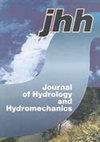冰盖下不同排列角度的非淹没支堤周围的河道变形
IF 2.4
4区 环境科学与生态学
Q3 WATER RESOURCES
引用次数: 0
摘要
本研究探讨了水面冰盖如何影响非沉没支堤周围河床的变形。使用两种不同粗糙度系数的模型冰盖和三种不同中值粒径的沙子进行了实验室实验。评估了非沉没式支墩的不同布置角度对最大冲刷深度和支墩周围冲刷模式的影响。结果表明,堤坝方向角是影响最大冲刷深度的关键因素。冰盖的存在及其粗糙系数会极大地影响支墩周围的河床变形。堤坝方位角、冰盖粗糙度和水流弗劳德数的综合影响导致了不同的冲刷模式。例如,当堤坝角度从 90º 变为 60º 时,冲刷孔的上游长度会减少约 60%,而流速增加约 50%时,冲刷孔的下游长度会增加 20%。考虑到冰盖、河床材料和堤坝布置角度的影响,已推导出确定支堤周围最大冲刷深度的方程。本文章由计算机程序翻译,如有差异,请以英文原文为准。
Channel deformation around non-submerged spur dikes with different alignment angles under ice cover
This study explores how the ice cover on water surfaces affects the deformation of the channel bed around non-submerged spur dikes. Laboratory experiments have been conducted by using two types of model ice cover with different roughness coefficients and three sands with different median grain sizes. The effects of various layout angles of non-submerged spur dikes on the maximum scour depth and scour patterns around spur dikes have been evaluated. Results showed that the dike orientation angle is the critical factor influencing the maximum scour depth. The presence of an ice cover and its roughness coefficient dramatically affect the channel bed deformation around spur dikes. The combined effect of the dike orientation angle, ice cover roughness, and flow Froude number resulted in different scour patterns. For instance, the upstream length of scour holes decreases by approximately 60% when the dike angle changes from 90º to 60º, while an increase in flow rate by about 50% leads to a 20% increase in the downstream length of scour holes. Equations have been derived to determine the maximum scour depth around spur dikes, considering the effects of ice cover, bed material and the dike layout angles.
求助全文
通过发布文献求助,成功后即可免费获取论文全文。
去求助
来源期刊
CiteScore
4.20
自引率
5.30%
发文量
30
审稿时长
>12 weeks
期刊介绍:
JOURNAL OF HYDROLOGY AND HYDROMECHANICS is an international open access journal for the basic disciplines of water sciences. The scope of hydrology is limited to biohydrology, catchment hydrology and vadose zone hydrology, primarily of temperate zone. The hydromechanics covers theoretical, experimental and computational hydraulics and fluid mechanics in various fields, two- and multiphase flows, including non-Newtonian flow, and new frontiers in hydraulics. The journal is published quarterly in English. The types of contribution include: research and review articles, short communications and technical notes. The articles have been thoroughly peer reviewed by international specialists and promoted to researchers working in the same field.

 求助内容:
求助内容: 应助结果提醒方式:
应助结果提醒方式:


